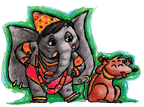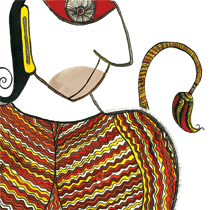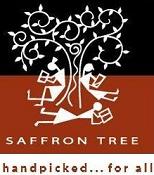Myths
Author: utbt19 May 2010
Mythological stories have always had a strong hold on me since childhood. No meal was complete without my chithi narrating a mythological story(because I begged and whined till she gave in). No story was complete without my chithi repeating, “Sapitunde kelu”(translates to: Eat as you listen) because I was so transfixed that I needed constant reminders to chew. But, I have my reservations when it comes to introducing mythological stories to my children. This dilemma of mine was the fodder for my first blog post. If I had written the same post today, I would have cut down on certain frills and made the post crisp, but the underlying issue would still be the same. The dilemma still continues.
I think, to some extent, I keep comparing the way I grew up with the way my children are growing up and I am afraid that my children might perceive the mythological story out of context. Since most of our mythological stories are religious, I am afraid that my children might extrapolate the inconsistencies in the story, the imperfections in the character as inconsistencies in religion. Adult perceptions and their role in child rearing is a full fledged research topic!
Amar Chitra Katha will always have a special place in my heart. When I see an ACK, I get mental images of summer holidays, burning sun, cool shade, tender coconut water, nungu (palm kernel), mangoes – ripe and raw and nothing can beat this nostalgia. But in the context of my children, I think ACK is still too much of he killed his brother, he made his wife walk in fire, she threw her children in the river and such. I wanted something beyond ACK.
So, I started looking for books on mythology that I am comfortable reading at home and given that this truly is the golden period for kids-lit in India, I am finding some good books on this subject.
 |
Vyasa’s Mahabaratha
Author: Chitra Krishnan. Illustration: Arun Kumar Translation: Aasai |
 |
Have you seen Jackie Chan movies?! After the movie, the rolling credits invariably show scenes from the making of the movie. It shows the bloopers. Silly, but always puts a smile on my face. That is the same effect this book had on me.
Tulika’s Vyasa Mahabaratha is not Mahabaratha, but the events leading to the writing of the epic. Vyasa’s search for a scribe and how Vyasa and Ganesha entered in to an agreement is the crux of this book.
I ordered the tamil version of the book. The tamil used in this book is certainly not the spoken tamil, but what my tamil class students will call as, ‘news reader’ tamil. I read it for my children and have to make sure that I translate. When what they hear is different from what they read, it is tough for children to understand. So it was up to me to make it interesting.
The story is narrated in a fun, lively manner. The illustrations are cartoonish with a Dumbledore looking Vyasa and a ‘thinni pandaram’(translates to: glutton ) Ganesha. I loved it. My children are getting used to it.
 |
Hanuman’s Ramayana
Author: Devdutt Pattanaik Illustrator: Nancy Raj Translation: Shankarramasubramaniyan |
 |
Mythology is considered as a symbolism. Myths were originally passed on through the tradition of oral story telling. In the days of yore, story telling was a form of entertainment. Story telling, I am sure, was cause of much excitement, celebration and was often associated with a religious occasion. Tulika’s Sweet And Salty talks about how the people in the village of Narasannapeta get excited when the story teller Gorannagaru visits to tell the story of Ramayana.
Hanuman’s Ramayana is not the story of Rama, but tells the readers that mythological stories might have different versions and the possibility of stories getting lost over time. I have personally heard two versions of Ramayana, one in which Ravana is the cruel villain and one in which he is Sita’s original father and took Sita captive for the good of the divine couple.
Basic things that I took away from this book is that a story can be molded to suit the ideas of the story teller. It changes and flows with the interpretation of the narrater. The story is bigger than the teller. It is not the who but the how and what that matters.
Nancy Raj’s illustrations are in Madhubani style. Lovely, intricate and in beautiful colors. We have three Tulika books illustrated by Nancy Raj(Village Fair, A-vil Yirundhu Ak-varai and Hanuman’s Ramayana) and each has its own style to suit the nature of the story. The concept of Hanuman’s Ramayana – ‘what is important is the story, not the story teller’. Nancy’s concept seems to be, ‘what is important is the art that compliments the story, not the artist’ and as a result the illustrations shine through.
 |
Ramayana The Divine Loophole
Author/Illustrator: Sanjay Patel |
 |
How can I talk about Ramayana and not talk about this book?! The key attraction for our family in this book are the illustrations. Sanjay Patel has used vector point illustrations to translate his sketches in to digital format using adobe illustrator. Four years of hard work, each page taking approximately seven days to finish and the result is this vibrant 185 page eye candy. I literally drooled. I have never see Ramyana illustrated like this before. Considering that this book came at the time, I was struggling to translate some of my sketches in to digital format using illustrator and photoshop and was throughly frustrated with the result, my respect for the book doubled. And of course, Sanjay Patel saying that Rama kneeled before Sita’s feet asking her forgiveness for having suspected her faithfulness and the authors note that ‘Times have changed, as have customs, but love has always been complicated’ agreed well with me 🙂
The tone of the book is very casual and the target audience is definitely the ‘non-hindu but is curious about the monkey god and such’ category. So if you are seeking deep spiritual advice and an insight in to hinduism then you are barking up the wrong tree.
Both my daughters love looking at the pictures in this book. They can sit for a good hour, just turning the glossy pages, absorbing the pictures.
My only gripe is about the illustration of Ravana. In order to make him symmetrical Sanjay Patel took poetic license and shows only nine heads. Like Maniratnam’s Ravan would say, he is ‘Das sir wale’ and not ‘Nao sir wale’ 🙁

 (No Ratings Yet)
(No Ratings Yet)
9 Responses for "Myths"
Wow! A great review! Na, my older one loves hearing our mythological stories, but I usually struggle to explain the killing and stuff in it! Do you order these books online?
UTBT KIDS: Yes, I order online. Tulika books, my parents ordered from my wish list and carried it to San Jose from Chennai. The Sanjay Patel book was from Amazon.
“Ramayana The Divine Loophole” reminded me of “The Hindu Deities” book. Whatdoyaknow.. its by the same illustrator!
UTBT SAYS: Ghee Happy series 🙂 Yes the same author/illustrartor.
awesome review as usual.
the vyasa book is awesome isnt it? total fun!
getting the ramayana book tmorrow – will let you know what i think then 🙂
and sanjay patel’s book sounds divine – some day..
UTBT SAYS: Thanks Chox. I sent you an email, pliss do chk.
excellent
any more to your list?
UTBT SAYS: Thanks SSST.
These
http://www.tarabooks.com/books/books/young-readers/tweens/the-mahabharatha-a-childs-view/
Hanuman’s Adventures in the Nether World from KATHA
Ma Ganga and the Razai Box also from KATHA
are on my wish list 🙂 Book fairy pliss to visit 🙂
God! you make me want to go buy all these books right now. I made a resolution not to buy any more books for the kids until Ashu learns to read fluently. But I can get these books for myself perhaps? I do read fluently! 😀
UTBT SAYS: Both the Tulika myths are in proper book-ish Tamil. The excuse is, I want the girls to exposed to ezhuthu Tamil. But guess who is reading it?!! So go ahead and buy. Or…. you can borrow the whole lot from me you know when.
Nice reviews – have never read any Tulika books – but from all the bloggers who are writing about them, am sure these are great
Another book whose stories can be easily adapted to the kiddie mindset is “Folk Tales from India” by A.K.Ramanujan – its an English translation of myraid tales from all over India – and retains the regional flavour of each story
On ACK – Bunnu drives me insane by questioning the manner in which Vali was driven away (I don’t use the word killed in anything I narrate to him) by Rama or why Karna was not accepted by his brothers – the sanitized version I tell him has steadily diverged from the original – does that make the whole effort obsolete ?
UTBT SAYS: Thanks for the suggestion PV. Will check it out when I get a chance.
In our house Vali gets a time out 🙂
and dumbledore is the perfect description of vyasa in the book!!!
UTBT SAYS: 🙂
Adorable pics.
“Rama kneeled before Sita’s feet asking her forgiveness for having suspected her faithfulness”
Now that is a story I’ld like to read and tell C too! We had the entire collection of ACK – bound into 10 or so volumes. I am sure my sis is still taking care of them and reading them. But I totally get your point abt ACK now for the kids.. I am wondering too as to how to introduce those books to the little one. My sis started on them when she was 3.. she turned out more than ok.. but then we are talking about life in India.
Next time I plan a trip back home, I am so getting a big list of all the Tulika books from you.
UTBT SAYS: Sure, will do. Though you will have difficulty separating my favs from the kids’ favs 🙂
Nice post. I came across a bunch of Indian/Hinduism books for kids in our local library in Kentucky. I was really surprised by the collection they had but my favorite was this book :
Elephant prince : the story of Ganesh / text by Amy Novesky ; illustrations by Belgin K. Wedman.
Just thought to share it with u. The pictures in this book are very beautiful and story style is simple that my 5 year old could follow patiently.
Longtime reader. First Time comment.
Seetha
UTBT SAYS: Thanks for taking the time to comment Seetha. Will surely check if this book is available in our local library.
Leave a reply